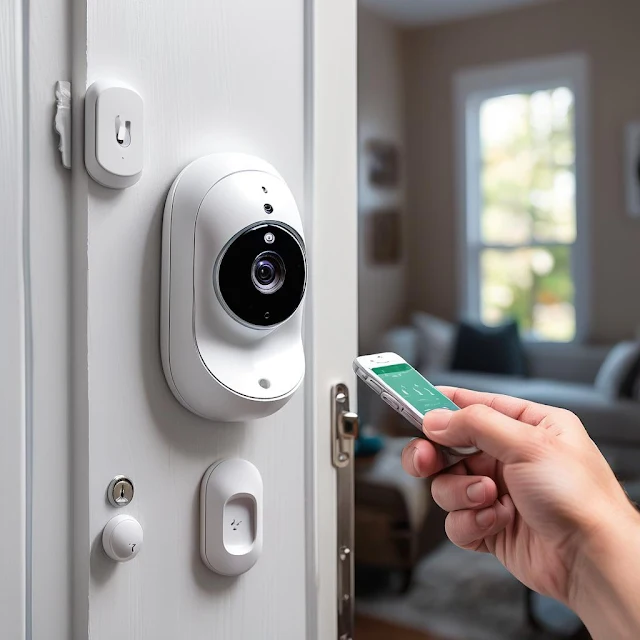In today's digital age, having a smart home security system is no longer a luxury but a necessity. With the rise in home burglaries and break-ins, it's crucial to invest in a reliable security system that can protect your loved ones and belongings. The good news is that you don't have to break the bank to secure your home - with the right DIY smart home security system, you can have peace of mind without spending a fortune.
Benefits of DIY Smart Home Security Systems
There are several benefits to opting for a DIY smart home security system over traditional security systems. Here are some of the key advantages:
Cost-Effective: DIY smart home security systems are more affordable than professionally installed systems, as you don't have to pay for installation fees or monthly monitoring costs. This makes it accessible for homeowners on a budget.
Easy Installation: Most DIY smart home security systems are easy to install and set up, with step-by-step instructions that you can follow without the need for professional help. This not only saves you money but also gives you the satisfaction of setting up your own security system.
Remote Monitoring: With a DIY smart home security system, you can monitor your home from anywhere using your smartphone or tablet, giving you peace of mind even when you're away. This feature allows you to keep an eye on your property at all times, enhancing your overall security.
Customization: DIY smart home security systems are highly customizable, allowing you to choose the components that best suit your needs and budget. Whether you want to start small and expand later or go all-in from the beginning, the flexibility of DIY systems caters to your specific requirements.
Components of DIY Smart Home Security Systems
When setting up a DIY smart home security system, there are several key components that you will need to consider. Here are some of the essential components to include in your system:
Motion Sensors: Motion sensors can detect movement in and around your home, triggering an alarm if an intruder is detected. These sensors provide an added layer of security by alerting you to potential threats.
Door and Window Sensors: Door and window sensors can alert you if someone tries to enter your home, providing an extra layer of security. By placing these sensors strategically, you can secure all entry points effectively.
Security Cameras: Security cameras allow you to monitor your home in real-time and record footage for future reference. With advancements in technology, you can now access high-definition video feeds from anywhere, enhancing your surveillance capabilities.
Smart Locks: Smart locks enable you to lock and unlock your doors remotely, giving you full control over who enters your home. This feature not only adds convenience but also enhances your home's security by allowing you to manage access efficiently.
Smoke and Carbon Monoxide Detectors: Smoke and carbon monoxide detectors can alert you to potential dangers in your home, keeping your family safe. These detectors provide early warnings in case of fire or gas leaks, ensuring the safety of your loved ones.
Tips for Setting Up a DIY Smart Home Security System
Setting up a DIY smart home security system may seem daunting at first, but with the right approach, you can create a secure and reliable system for your home. Here are some tips to help you get started:
Assess Your Needs: Start by assessing your home security needs and identifying the areas that require the most protection. This will help you prioritize which components to include in your system.
Research: Take the time to research different DIY smart home security systems and compare their features and prices to find the best option for your home. Look for user reviews and ratings to ensure you're making an informed decision.
Plan Your System: Plan out the components of your DIY smart home security system, including where to place sensors and cameras for optimal coverage. Consider factors such as entry points, blind spots, and high-risk areas when designing your system.
Install with Care: Follow the manufacturer's instructions carefully when installing your DIY smart home security system to ensure that it works correctly. Proper installation is crucial for the effectiveness of your security system, so take your time and double-check your work.
Test Your System: Once your system is set up, test it regularly to ensure that all components are functioning correctly and that you are receiving alerts as expected. Conduct routine checks to verify that your system is operational and address any issues promptly.
By following these tips and investing in a DIY smart home security system, you can protect your home and loved ones without breaking the bank. Stay safe and secure with a smart home security system that gives you peace of mind 24/7.
FAQ
Are DIY smart home security systems cost-effective?
Yes, DIY smart home security systems are more affordable than professionally installed systems, as you don't have to pay for installation fees or monthly monitoring costs.
What are some key benefits of DIY smart home security systems?
Some key benefits include easy installation, remote monitoring capabilities, and high customization options to suit your specific needs and budget.
What are some essential components to include in a DIY smart home security system?
Essential components include motion sensors, door and window sensors, security cameras, smart locks, and smoke and carbon monoxide detectors.
What tips can help in setting up a DIY smart home security system effectively?
Tips include assessing your needs, researching different systems, planning out your system components strategically, installing with care following instructions, and testing the system regularly to ensure proper functionality.

Comments
Post a Comment